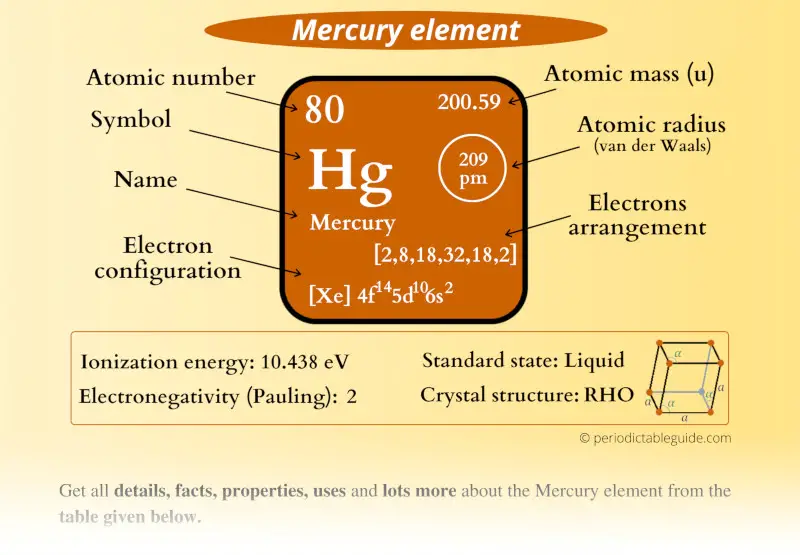
This is a SUPER easy guide on Mercury element.
In fact, the table mentioned below is the perfect information box (Which gives you every single detail about the Mercury element in Periodic table.)
So if you want to know anything about Mercury element, then this guide is for you.
Let’s dive right into it!
Mercury Element (Hg) Information
| Appearance |  Shiny liquid |
| State (at STP) | Liquid |
| Position in Periodic table | 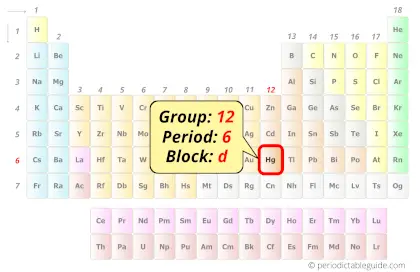 Group: 12, Period: 6, Block: d |
| Category | 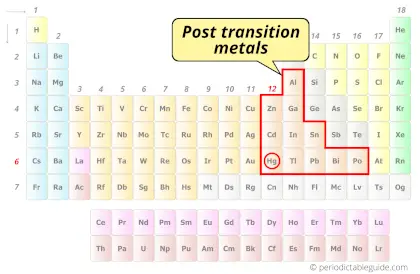 Post transition elements |
| Atomic number or Protons | 80 |
| Neutrons | 121 |
| Electrons | 80 |
| Symbol | Hg |
| Atomic mass | 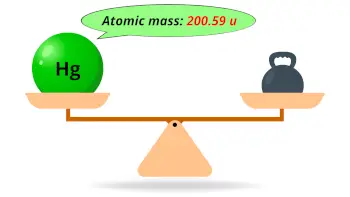 200.59 u |
| Electrons arrangement or Bohr model | 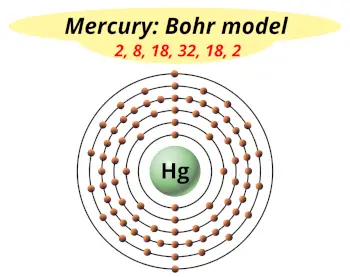 2, 8, 18, 32, 18, 2 |
| Electronic configuration | [Xe] 4f14 5d10 6s2 |
| Atomic radius | 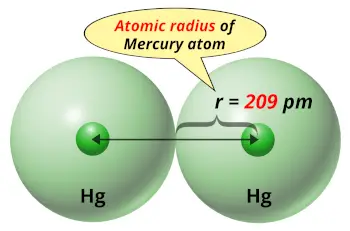 209 picometers (van der Waals radius) |
| 1st Ionization energy | 10.438 eV |
| Electronegativity | 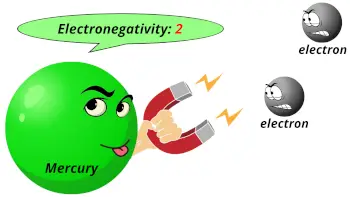 2 (Pauling scale) |
| Crystal structure | 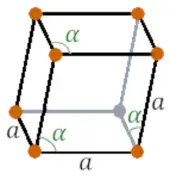 Rhombohedral |
| Melting point | 234.3 K or -38.8 °C or -37.8 °F |
| Boiling point | 629.8 K or 356.7 °C or 674.1 °F |
| Density | 13.535 g/cm3 |
| Main isotope | 202Hg |
| CAS number | 7439-97-6 |
Mercury in Periodic table
Mercury element is in group 12 and period 6 of the Periodic table. Mercury is the d-block element and it belongs to Post transition elements group.
| H | He | ||||||||||||||||
| Li | Be | B | C | N | O | F | Ne | ||||||||||
| Na | Mg | Al | Si | P | S | Cl | Ar | ||||||||||
| K | Ca | Sc | Ti | V | Cr | Mn | Fe | Co | Ni | Cu | Zn | Ga | Ge | As | Se | Br | Kr |
| Rb | Sr | Y | Zr | Nb | Mo | Tc | Ru | Rh | Pd | Ag | Cd | In | Sn | Sb | Te | I | Xe |
| Cs | Ba | La* | Hf | Ta | W | Re | Os | Ir | Pt | Au | Hg | Tl | Pb | Bi | Po | At | Rn |
| Fr | Ra | Ac** | Rf | Db | Sg | Bh | Hs | Mt | Ds | Rg | Cn | Nh | Fl | Mc | Lv | Ts | Og |
| *Ce | Pr | Nd | Pm | Sm | Eu | Gd | Tb | Dy | Ho | Er | Tm | Yb | Lu | ||||
| **Th | Pa | U | Np | Pu | Am | Cm | Bk | Cf | Es | Fm | Md | No | Lr |
←Move to: Gold (Au) element – Periodic Table
→Move to: Thallium (Tl) element – Periodic Table
Why is Mercury in Period 6?
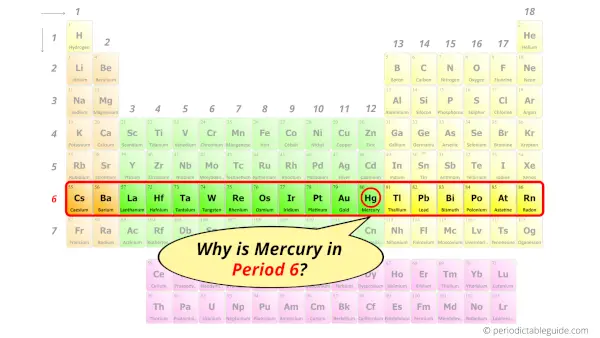
Let me ask you a question.
How many shells does mercury atom have?
It’s 6. Right?
You have already seen the bohr model of mercury atom in the above table.
From the Bohr model, it can be found that the number of orbits or shells in mercury is 6. Hence, as mercury has 6 orbits, it lies in period 6 of the Periodic table.
Why is Mercury in d-block?
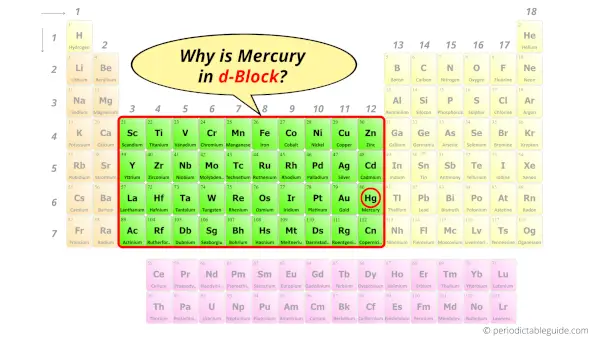
Before knowing this reason, first of all I want to ask you a simple question.
How can you determine the blocks-wise position of elements?
The simple answer: The elements will lie in the s, p, d or f block will completely depend upon the subshell in which the last electron will enter.
For example; the electron configuration of mercury is [Xe] 4f14 5d10 6s2.
Here, the last electron of mercury enters the d-subshell or d-orbital.
Hence, mercury is the d-block element.
Is Mercury a Transition Metal? Why?
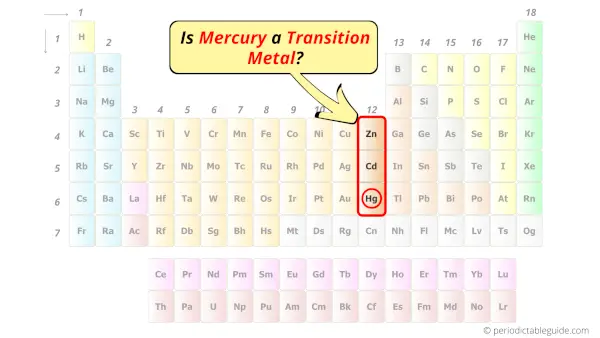
No, Mercury is not a transition metal because it has completely filled d-orbital in its ground state.
Let me explain the exact meaning of this.
According to the definition of transition metals;
The element should compulsorily have incomplete d-orbitals, either in their ground state (M) or most common oxidation states (M1+, M2+, etc) then only they are called transition metals.
Now, the ground state of Mercury means its normal state in which it has neither gained nor lost any electron/s.
So the ground state of Mercury is Hg.
And the ground state electronic configuration of Mercury is [Xe] 4f14 5d10 6s2.
In this state, if we see the electron configuration of Mercury, then it possesses 10 electrons in d-orbitals.

This indicates that the d-orbitals of Mercury are completely filled.
And hence, as Mercury has completely filled d-orbitals, it is not considered as a transition metal.
7 Facts about Mercury element
Interesting facts about mercury element are mentioned below.
- Mercury is the only metal that is liquid at room temperature.
- The concentration of mercury present in the earth’s crust is approximately 80 parts per billion by weight.
- Although mercury is liquid at room temperature, it is approximately 13.5 times heavier than water.
- Mercury is obtained from its mineral ore mercury sulfide (HgS) from the earth’s crust.
- Mercury is toxic and it should be kept away from childrens and pets. Even mercury should not be handled with bare hands.
- Spain and Italy are the leading producers of mercury in the world.
- Mercury is the 67th common element found from the earth’s crust.
Properties of Mercury
The physical and chemical properties of mercury element are mentioned below.
Physical properties of Mercury
Physical properties of mercury are mentioned below.
- Mercury element is a Shiny liquid metal at room temperature.
- The melting point of mercury is -38.8 °C and its boiling point is 356.7 °C.
- If mercury is spilled on the surface, it will form small spherical droplets.
- The crystal structure of mercury is Rhombohedral.
- There are many isotopes of mercury, but out of those isotopes, the most abundant isotope is 202Hg (which has an abundance of approximately 29.7%).
- The atomic mass of 200.59 u and its density is 13.535 g/cm3.
Chemical properties of Mercury
Chemical properties of mercury are mentioned below.
- Mercury is highly toxic for humans as well as animals. It can enter our body from wounds and can damage the nerves, kidneys, levers, and it can cause other illnesses too.
- Mercury does not form oxide in the presence of dry air. But if the air contains moisture, then mercury will tarnish and form oxide coating on it.
- Mercury has a capacity to form amalgams (alloys) with metals like silver, gold and tin.
- Mercury does not form alloy with iron, so it is commonly stored in iron containers.
- Mercury forms an amalgam with aluminum. Even a small amount of mercury can destroy the oxide layer on aluminum. Because of this reason, mercury is not allowed in aircrafts.
Uses of Mercury
Uses of mercury are mentioned below.
- Mercury is very often used in thermometers and many other temperature measuring instruments. But nowadays the mercury thermometers are replaced by digital thermometers.
- Because of higher density of mercury, it is also used in pressure measuring devices like barometers, manometers, etc.
- As mercury can easily amalgamate with gold and silver, it is used in extracting those metals from their ores.
Explore our New Interactive Periodic Table (with Rotating Bohr Models and More)

Details about this Periodic table:
- Access detailed info on all elements: atomic mass, electron configurations, charges, and more.
- View rotating Bohr models for all 118 elements.
- Get a free HD image of the Periodic Table.
Note: For future use, bookmark this Periodic table or visit “PeriodicTableGuide.com”
External resources:
- Mercury (element) – Wikipedia. (2015, February 18). Mercury (Element) – Wikipedia. https://en.wikipedia.org/wiki/Mercury_(element)
- Mercury – Element information, properties and uses | Periodic Table. (n.d.). Mercury – Element Information, Properties and Uses | Periodic Table. https://www.rsc.org/periodic-table/element/80/mercury
- Basic Information about Mercury | US EPA. (2015, August 20). US EPA. https://www.epa.gov/mercury/basic-information-about-mercury
- It’s Elemental – The Element Mercury. (n.d.). It’s Elemental – the Element Mercury. https://education.jlab.org/itselemental/ele080.html
- P. (n.d.). Mercury | Hg (Element) – PubChem. Mercury | Hg (Element) – PubChem. https://pubchem.ncbi.nlm.nih.gov/element/Mercury
- C&EN: IT’S ELEMENTAL: THE PERIODIC TABLE – MERCURY. (n.d.). C&EN: IT’S ELEMENTAL: THE PERIODIC TABLE – MERCURY. https://pubsapp.acs.org/cen/80th/mercury.html?
- Mercury. (n.d.). Mercury. https://nature.berkeley.edu/classes/eps2/wisc/hg.html
- Boudreaux, K. A. (n.d.). Molecule Gallery – Alkenes. Molecule Gallery – Alkenes. https://www.angelo.edu/faculty/kboudrea/molecule_gallery/element080_mercury/00_mercury.htm
- Mercury: Element of the Ancients | Dartmouth Toxic Metals. (n.d.). Mercury: Element of the Ancients | Dartmouth Toxic Metals. https://sites.dartmouth.edu/toxmetal/mercury/mercury-element-of-the-ancients/
